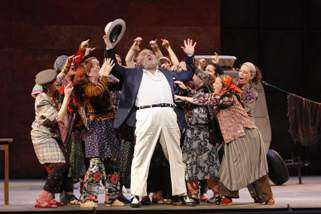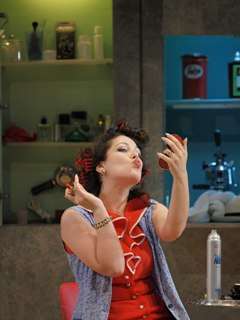|
Back
Turco Splendissimo Los Angeles
Dorothy Chandler Pavilion
02/19/2011 - and February 27, March 2, 5, 10, 13, 2011
Gioachino Rossini: Il Turco in Italia
Simone Alberghini (Selim), Nino Machaidze (Fiorilla), Thomas Allen (Prosdocimo), Paolo Gavanelli (Don Geronio), Maxim Mironov (Don Narisco), Kate Lindsey (Zaida), Matthew O’Neill (Albazar)
Roberto Cani (Guest Concertmaster), Grant Gershon (Associate Conductor/Los Angeles Opera Chorus Master), James Conlon (Conductor)
Axel Weidauer (Stage Director), Cristof Loy (Original Production), Herbert Maurauer (Scenery and Costume Designer), Reinhard Traub (Lighting Designer), Jacqueline Davenport (Original Choreography), Kristin Schaw Minges (Choreographer)

(© Robert Millard)
Taut libretto, rapidly paced, beautiful score and antics galore. These are a few of the descriptions that befit Gioachino Rossini’s germinal work Il Turco in Italia that was, ironically, received with disdain on opening night in 1814 at La Scala. This cynicism can be traced back to the public’s perception of Il Turco in Italia as being a rehashed sequel to L’Italiana in Algeri (1813). Even though Rossini extracted sections of La Cenerentola, Ciro in Babilonia and the aforementioned, Il Turco in Italia surprisingly contains fresh passages and musical inventions. After the last production in Budapest in 1847 (by then warmly received), the opera would disappear from the repertoire for 101 years until it was rediscovered by composer Boris Goldovsky in a revival held at the 1948 Tanglewood Festival. Two years later Maria Callas gave greater fame to Il Turco in Italia, facilitating its revival worldwide.
Conductor James Conlon’s relationship with the opera is a personal journey, for in 1964 he saw Il Turco in Italia while volunteering as a stage hand and was instantly smitten. This is the first time Los Angeles Opera has staged the work, and it is the first time James Conlon has seen the opera since he was 14 years old. Quite remarkable. From orchestra pit to stage, enthusiasm reigns supreme in this jocular Axel Weidauer directed dramma buffo.
Drawing forces on both sides of the fence, Christof Loy triumphs with a universal setting that represents an amalgam of timelines which are indicative of the types of dress worn throughout. Toward the end of the overture, we witness an endless parade of twenty something “Woodstockish” color-clad gypsies emptying out of a 1940’s style mini caravan that sets the tone of the ensuing comedy.
Here we’re introduced to Kate Lindsey’s artful portrayal as former slave Zaida while the Prosdocimo eyes the troupe as a first layer of an unfolding buffo he’s writing. Thomas Allen’s role as the poet is an important one as he weaves himself between being engulfed in the soap opera to removing himself to become an outside narrator. The British baritone, though dapperly dressed in a black suit, progressively gets ensnared in the ensuing battles and becomes more and more beat up, finally appearing as a damaged man complete with bandaged head, leg cast and crutch. Allen’s forays into follies is a hit.
At the heart of the story lies the hilarious conflict between the jealous husband Don Geronio and his capricious tart of a wife, Fiorilla, both having equal challenges in acting and vocal regimens. Paolo Gavanelli’s Geronio shakes with boisterousness and retains a keenly virile baritone voice, with a particularly incredible “pattering” technique found in “Per piacere alla signora.”

(© Robert Millard)
After a resounding success as Adina in last year’s L’elisir d’amore at Los Angeles Opera, returning Georgian Nino Machaidze is an operatic master on all levels. Having gained vocal maturity, she handles the complexities of acting effortlessly while delivering song with alacrity and clarity. One of the most memorable (if not the best) passages in the opera is her deliverance of “Squallida veste, e bruna” in Act II. It is absolutely amazing and pure joy, as evidenced by the lengthy applause following the extended coloratura aria.
Sophisticated whimsy can describe Herbert Maurauer’s set design and costuming. The stage is anchored by Tuscan colored faux marble walls that contain a set of immense floor to ceiling metal-like moving doors. These doors open inconspicuously to reveal scenes such as a coastal view of Naples (the arrival of Selim on a flying magic carpet) and formal staircase replete with two chandeliers (during the masked ball). This technique is seamless, never detracting from the action on stage. There is even a slowly moving Japanese screen panel that has several hidden compartments including a door, a mirror vanity (for Fiorilla’s primping), a coffee espresso bar (used during the Fiorilla/Selim duet) and a shoe rack rivaling that of Emelda Marcos for Fiorella. In hand with the sets is the imaginative choreography of Kristin Schaw Minges. Chorus members alternate speed of movement, from brisk run to slow motion. This technique is used masterfully alongside the sextet concluding Act I in “Ah! Che il cor non m’ingannava.”
In Act II, two racks of clothes depicting a store wardrobe that will be “consulted” for an appropriate dress disguise drop from the ceiling. Amongst the apparel hides Fiorella’s unrequited lover, Don Narisco played by debuting Maxim Mironov. Not new to bel canto roles, the young Russian tenor has sung extensively with several Italian opera houses and the Rossini Opera festival. The suitor is a sort of impish James Dean gifted with silky tonal attributes, reminiscent of a softened Juan Diego Flórez. At the end of the opera he rides a bicycle donning a gray suit looking as though he’s just returned from the set of Catán’s Il Postino. Mironov is youthful and effervescent.
The opera would not be complete without the Turk himself, performed by Simone Alberghini. Having visited Los Angeles in Il barbiere di Sigivlia and Roméo et Juliette on previous occasions, the bass-baritone sings the role of Selim, a caricature of machismo. He interacts with the other cast members respectfully and embodies masculinity. Especially amusing is his face-off in the wresting ring with Don Geronio when the Turk brashly offers to buy Fiorella from Don Geronio; the stretto with Machaidze is piquant and polished.
Humor can go overboard, but Los Angeles Opera restrains itself by delivering a production filled with intelligent humor. One of Rossini’s finest comic operas, this Il Turco in Italia is entertaining and delightful; a must see for those new to opera. You will not be disappointed.
Christie Grimstad
|